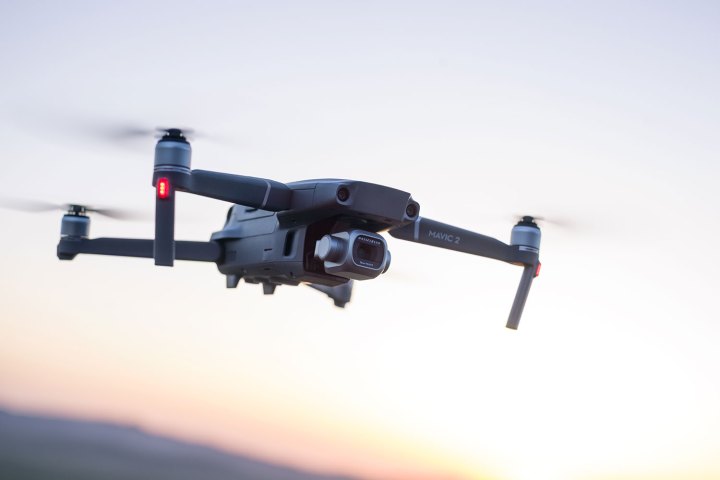
DJI unveiled the Mavic 2 series of drones today, expanding the Mavic line beyond the highly successful Mavic Pro and Mavic Air. The two new drones, the Mavic 2 Pro and Mavic 2 Zoom, have identical dimensions and flight specifications (here’s our rundown of all the key features) — the only difference is in the cameras, and it’s pretty significant. Take a look at the specs below, or jump to the bottom of table for a breakdown of what they mean.
Read our DJI Mavic 2 Pro and Zoom review
DJI Mavic 2 Zoom |
||
| Dimensions
(length×width×height) |
Folded: 214×91×84 mm
Unfolded: 322×242×84 mm |
Folded: 214×91×84 mm
Unfolded: 322×242×84 mm |
| Weight | 907 grams | 905 grams |
| Maximum flight time | 31 minutes | 31 minutes |
| Image sensor | 1-inch-type, 20MP | 1/2.3-inch, 12MP |
| Lens | 28mm, f/2.8-16 | 24-48mm, f/2.8 (24mm) f/3.8 (48mm) |
| Still photo resolution | 5472×3648 | 4000×3000 |
| Still photo filetype | JPEG/DNG (RAW) | JPEG/DNG (RAW) |
| Video resolution and framerate | 4K: 3840×2160 (24/25/30 fps)
2.7K: 2688×1512 (24/25/30/48/50/60 fps) FHD: 1920×1080 (24/25/30/48/50/60/120 fps) |
4K: 3840×2160 (24/25/30 fps)
2.7K: 2688×1512 (24/25/30/48/50/60 fps) FHD: 1920×1080 (24/25/30/48/50/60/120 fps) |
| Color mode | DLog-M 10-bit | D-Cinelike 8-bit |
| Video filetype | MP4 / MOV (MPEG-4 AVC/H.264, HEVC/H.265) | MP4 / MOV (MPEG-4 AVC/H.264, HEVC/H.265) |
| Price | $1,449 | $1,249 |
A symphony of sensors
This is probably the most important difference between the two models. The 1/2.3-inch sensor in the Mavic 2 Zoom is about what you’d expect to find in a smartphone or entry-level compact camera, whereas the Mavic 2 Pro features a larger 1-inch sensor — the same format popularized by Sony in the RX100 series of advanced compact cameras. Not only does it offer higher resolution (20 megapixels compared to 12), but a larger sensor can collect more light and thus produce better image quality — however, that doesn’t necessarily make the Mavic 2 Pro better, as we’ll get into below.
The new lenses
As a larger sensor requires larger glass, the Mavic 2 Pro doesn’t have a zoom lens, instead making due with a fixed 28mm (full-frame equivalent). It does have a mechanical aperture, however, with a range of f/2.8-f/11, which lets the camera work in a variety of light conditions without having to ramp up the shutter speed.
The smaller glass requirement of the 1/2.3-inch sensor is what allowed DJI to fit a 2x zoom onto the Mavic 2 Zoom. Here, the modest 24-48mm (full-frame equivalent) zoom range isn’t just about bringing objects closer, it’s also about creative effects. Shooting at 48mm compresses distance and adds drama to the camera moves. For example, with the drone rotating around your subject, the background will appear to move at super speed (for better or worse, it’s a technique Michael Bay utilizes often).
Additionally, a built-in dolly zoom mode makes it easy to capture this classic camera technique — often called the “Hitchcock zoom” for its use in the film Vertigo — where you zoom and dolly (or in this case, fly) at the same time. This causes an unsettling warping of the image and is normally quite tricky to pull off, but DJI makes it easy.
What the heck is 10-bit DLog-M ?
This is another feature unique to the Mavic 2 Pro. DLog-M is DJI’s name for its logarithmic tone curve, which is a way for a camera to capture more detail by preserving greater dynamic range. Essentially, it records a very, very low contrast image so that highlights don’t blow out and shadows don’t turn pure black — but the footage has to be color graded before it looks normal. Thus, DLog-M is something professional filmmakers will be very happy to have — but it’s not a feature that will necessarily make things easier for the rest of us.
10-bit refers to the color depth of the image, and is not related to the bitrate of the video file (which is 100 megabits per second on both new drones). We have a more detailed explainer of how this works, but most of the video and images you see online are shot in 8-bit color, which provides 256 levels of luminance per color channel. 10-bit increases that number to 1,024, making for richer colors and smoother transitions between colors. Like DLog-M, this is a feature that really only pros will need.
Which Mavic 2 is right for you?
The general consumer is likely to be happier with the Mavic 2 Zoom. It offers greater flexibility with its 2x zoom lens, opens up some fun and automated creative shots, and it costs $200 less at $1,249.
The Mavic 2 Pro, as the name implies, is better suited for professional users. It has a clear edge in image quality thanks to its larger sensor, 10-bit color, and log gamma. That said, it can’t achieve the same perspectives as the Mavic 2 Zoom — so frankly, pros may want to pick up both. The Mavic 2 Pro retails for $1,449.




